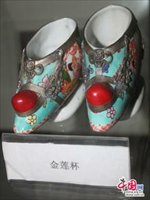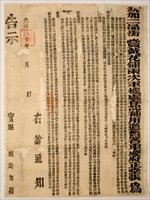Broken soles: 10 centuries of foot-binding
| Editor's Note |
| Photo gallery |
| Quotes |
Zhou Guizhen, 86, says she regrets binding her feet:
|
|||||||||||||||
79-years-old Wang Lifen, villager of Liuyi says:
This process usually lasts for 10 years as the foot grows to maintain and ensure the foot’s small shape.
The most common ailment suffered from bound feet was infection. Despite the amount of care taken to regularly trim toenails, they would often in-grow, cause bleeding and become infected. Because foot-binding impeded blood circulation, any injury to the toes was unlikely to heal properly, resulting in severe infection and rotting flesh. Blood poisoning (septicemia) and death sometimes followed infection. Even if a woman survived infection, it was not unusual for the foot itself to die after three years, leaving a terrible stench that would follow the woman for the rest of her life.
Source: Chinese Foot-Binding
Source: Illustrated Hard Book of Chinese Sex History
Source: Consequences of foot-binding among older women in Beijing, China
Some estimate that as many as 2 billion Chinese women broke and bound their feet to attain this agonizing ideal of physical perfection. Source: The Sex Life of the Foot and Shoe |
| History of foot-binding |
| Origins | |
|
|
The general consensus is that the practice originated during the time of Emperor Li Yu of the Southern Tang Dynasty (937-975). Emperor Li Yu asked his concubine Yin Niang (银娘) to bind her feet in white silk into the shape of a crescent moon, after which she performed a ballet-like ‘lotus dance’ on the points of her feet. Yin Niang was described as so graceful that she could 'skim the top of a golden lotus'. Her performance won the heart of the emperor and she became his favorite concubine. His other concubines, looking to similarly captivate his attention, began imitating Yin Niang by binding their feet. |
| Development | |
 |
● The practice of foot-binding became increasingly popular during the Song Dynasty (960-1279), and continued through the Yuan (1279-1398) and Ming Dynasties (1368-1644). ●Song Dynasty (960-1279): Bound feet were primarily seen as a symbol of eroticism among men. By the end of the Song Dynasty, it was customary to drink from a special shoe whose heel contained a small cup. During the Yuan Dynasty, some would also drink directly from the shoe itself. |
| Demise | |
 |
●In 1664, emperor Kangxi of the Qing Dynasty (1644-1911) attempted to ban the practice. His attempt was thwarted about four years later by the Ministry of Rites, who urged the retraction of the ban. ●In 1874, the first anti foot-binding committee was formed in Shanghai by a British priest. ●In 1874, a 60-year-old Christian woman in Xiamen publically campaigned for an end to the practice. Her cause was taken up by the Woman's Christian Temperance Movement in 1883, and found champions with missionaries such as Timothy Richard, who believed that Christianity could promote equality between the sexes. These campaigns were also enthusiastically supported by scholar-philosopher Liang Qichao (1873-1929) and political reformist Kang Youwei (1858-1927) in the late Qing Dynasty (1644-1911). The Young Women's Christian Association (YWCA), founded in the late nineteenth century, initially focused its energies on foot-binding. ●In 1902, foot-binding was also outlawed by the imperial edicts of the Qing Dynasty. ●In 1912, after the fall of the Qing Dynasty, the new Nationalist government of the Republic of China banned foot-binding, though, like previous bans, was not always successful. ●In 1915, the Nationalist government declared the practice illegal and sent inspectors to issue monetary fines to those who continued to uphold the tradition. ●The practice finally died out by the 1950s after the founding of new China, due to a series of anti foot-binding campaigns by the government. source: The Religious Question in Modern China Chinese Foot-Binding |
| Related Books |
Cinderella's Sisters: A Revisionist History of Footbinding Author: Dorothy Ko
Every Step a Lotus: Shoes for Bound Feet Author: Dorothy Ko
Splendid Slippers: A Thousand Years of an Erotic Tradition Author: Beverley Jackson
Chinese Women and Rural Development: Sixty Years of Change in Lu Village, Yunnan Author: Laurel Bossen
The Lotus Lovers: The Complete History of the Curious Erotic Custom of Footbinding in China Author: Howard S. Levy, Arthur Waley
Web editor: wangnan1@globaltimes.com.cn